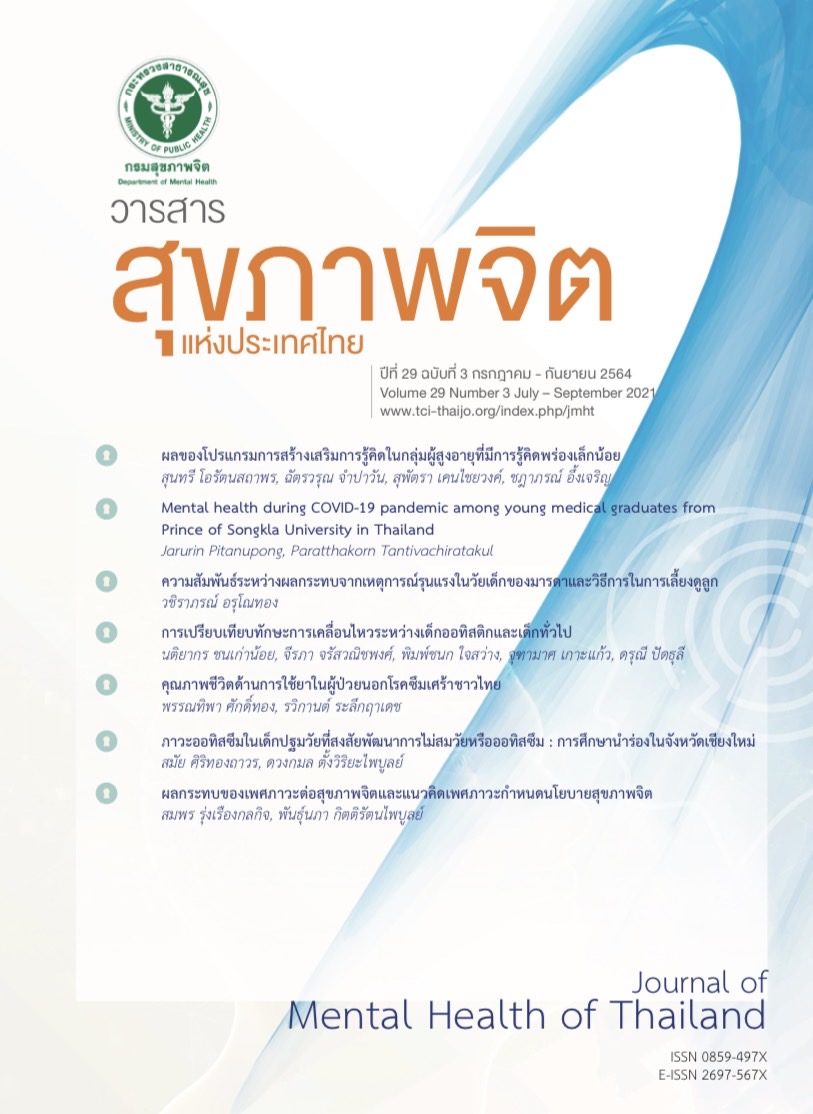การเปรียบเทียบทักษะการเคลื่อนไหวระหว่างเด็กออทิสติกและเด็กทั่วไป
คำสำคัญ:
ทักษะการเคลื่อนไหว, ออทิสติก, อายุพัฒนาการบทคัดย่อ
วัตถุประสงค์ : เพื่อศึกษาความบกพร่องของทักษะการเคลื่อนไหวในเด็กออทิสติก และเปรียบเทียบทักษะการเคลื่อนไหวระหว่างเด็กออทิสติกและเด็กทั่วไป
วิธีการ : กลุ่มตัวอย่างจำนวน 60 คน (เด็กออทิสติก 30 คน เด็กทั่วไป 30 คน) ช่วงอายุ 3 - 5 ปี ได้รับการทดสอบทักษะการเคลื่อนไหวโดยใช้แบบประเมิน Peabody development motor scale-2 (PDMS-2) ใน 3 ด้าน ได้แก่ การรักษาความมั่นคงของท่าทางเมื่ออยู่นิ่ง การเคลื่อนที่จากที่หนึ่งไปอีกที่หนึ่ง และการจัดการกับวัตถุ ค่าคะแนนแต่ละด้านถูกปรับเป็นค่าคะแนนมาตรฐาน และคำนวณอายุพัฒนาการเพื่อเปรียบเทียบกับอายุจริง ค่าคะแนนรวมทุกด้านถูกแปลงเป็นค่า gross motor quotient (GMQ) เพื่อวัดระดับความบกพร่องของทักษะการเคลื่อนไหวโดยใช้กล้ามเนื้อมัดใหญ่ วิเคราะห์ข้อมูลด้วยสถิติเชิงพรรณนาและเชิงเปรียบเทียบด้วยสถิติ independent sample t-test และ paired-sample t-test
ผล : เด็กออทิสติกมีค่าคะแนนมาตรฐานด้านการรักษาความมั่นคงของท่าทางเมื่ออยู่นิ่ง การเคลื่อนที่จากที่หนึ่งไปอีกที่หนึ่ง และการจัดการกับวัตถุ ต่ำกว่าเด็กทั่วไปในวัยและเพศเดียวกัน และมีอายุพัฒนาการต่ำกว่าอายุจริงอย่างมีนัยสำคัญทางสถิติ (p < .001) เด็กออทิสติกส่วนใหญ่มีค่า GMQ ของทุกด้านอยู่ในเกณฑ์ต่ำกว่าค่าเฉลี่ยมาตรฐาน โดยเฉพาะด้านการรักษาความมั่นคงของท่าทางเมื่ออยู่นิ่ง
สรุป : เด็กออทิสติกอายุ 3 - 5 ปี มีความบกพร่องของทักษะการเคลื่อนไหวและมีทักษะการเคลื่อนไหวต่ำกว่าเด็กทั่วไปควรพิจารณาให้กายภาพบำบัดเพื่อแก้ไขปัญหาแทรกซ้อนการเคลื่อนไหวภายหลัง
Downloads
เอกสารอ้างอิง
Lord C, Bishop SL. Recent advances in autism research as reflected in DSM-5 criteria for autism spectrum disorder. Annu Rev Clin Psychol. 2015;11:53–70. doi:10.1146/annurev-clinpsy-032814-112745.
Christensen DL, Maenner MJ, Bilder D, Constantino JN, Daniels J, Durkin MS, et al. Prevalence and characteristics of autism spectrum disorder among children aged 4 years - early autism and developmental disabilities monitoring network, seven sites, United States, 2010, 2012, and 2014. MMWR Surveill Summ. 2019;68(2):1-19. doi:10.15585/mmwr.ss6802a1.
สถาบันราชานุกูล กรมสุขภาพจิต. เด็กออทิสติก คู่มือสำหรับพ่อแม่/ผู้ปกครอง [Autistic children a parent/guardian's guide]. พิมพ์ครั้งที่ 3. กรุงเทพฯ: โรงพิมพ์ชุมนุมสหกรณ์การเกษตรแห่งประเทศไทยจำกัด; 2557.
เพ็ญแข ลิ่มศิลา. การวินิจฉัยออทิสซึม [Diagnosis of autism]. สมุทรปราการ: ช.แสงงามการพิมพ์; 2540.
Autistic society of America. What is autism? [Internet]. Maryland USA; 2020 [cited 2020 Mar 31]. Available from: http://www.autism-society.org/what-is/.
ศรีวรรณา พูลสรรพสิทธิ์, เบญจพร ปัญญายง, ดุสิต ลิขนะพิชิตกุล, ประยุกต์ เสรีเสถียร, วรรณา จุฑา. การศึกษาภาวะออทิซึมในประเทศไทยและการดูแลรักษาแบบบูรณาการในระดับประเทศ [Holistic care for Thai autism]. วารสารสุขภาพจิตแห่งประเทศไทย. 2548;13(1):10-6.
American Psychiatric Association. Diagnostic and statistical manual of mental disorders. 5th ed. Arlington, VA: American Psychiatric Association; 2013.
Teitelbaum P, Teitelbaum O, Nye J, Fryman J, Maurer RG. Movement analysis in infancy may be useful for early diagnosis of autism. Proc Natl Acad Sci USA. 1998;95(23):13982-7. doi:10.1073/pnas.95.23.13982.
Ketcheson L, Hauck JL, Ulrich D. The levels of physical activity and motor skills in young children with and without autism spectrum disorder, aged 2-5 years. Autism. 2018;22(4):414-23. doi:10.1177/1362361316683889.
Provost B, Lopez BR, Heimerl S. A comparison of motor delays in young children: Autism Spectrum Disorder, Developmental Delay, and Developmental Concerns. J Autism Dev Disord. 2007;37(2):321-8.11. doi:10.1007/s10803-006-0170-6.
Pan CY, Tsai CL, Chu CH. Fundamental movement skills in children diagnosed with autism spectrum disorders and attention deficit hyperactivity disorder. J Autism Dev Disord. 2009;39(12):1694-705. doi:10.1007/s10803-009-0813-5.
Ketcheson. L, Hauck. JL, Ulrich D. The effects of an early motor skill intervention on motor skills, levels of physical activity, and socialization in young children with autism spectrum disorder: A pilot study. Autism. 2017;21(4):481-92. doi:10.1177/1362361316650611.
Holloway JM, Long T, Biasini F. Concurrent validity of two standardized measures of gross motor function in young children with autism spectrum disorder. Phys Occup Ther Pediatr. 2019;39(2):193-203. doi:10.1080/01942638.2018.1432006.
Tavasoli A, Azimi P, Montazari A. Reliability and validity of the peabody developmental motor scales-second edition for assessing motor development of low birth weight preterm infants. Pediatr Neurol. 2014;51(4):522-6. doi:10.1016/j.pediatrneurol.2014.06.010.
Bremer E, Balogh R, Lloyd M. Effectiveness of a fundamental motor skill intervention for 4-year-old children with autism spectrum disorder: A pilot study. Autism. 2015;19(8):980-91. doi:10.1177/1362361314557548.
Wang. H-H, Liao. H-F, Hsieh C-L. Reliability, sensitivity to change, and responsiveness of the peabody developmental motor scales-second edition for children with cerebral palsy. Phys Ther. 2006;86(10):1351-9. doi:10.2522/ptj.20050259.
Folio. MR, Fewell RR. Peabody developmental motor scales examiner's manual. 2nd ed. Texas USA: Pro-Ed; 2000.
พรรณี ปิติสุทธิธรรม, ชยันต์ พิเชียรสุนทร, บรรณาธิการ. ตำราการวิจัยทางคลินิก ฉบับปรับปรุงใหม่ [Textbook of clinical research fourth edition revised and expanded]. พิมพ์ครั้งที่ 4. กรุงเทพฯ: คณะเวชศาสตร์เขตร้อน มหาวิทยาลัยมหิดล; 2561.
Holloway JM, Long TM, Biasini F. Relationships between gross motor skills and social function in young boys with autism spectrum disorder. Pediatr Phys Ther. 2018;30(3):184-90. doi:10.1097/PEP.0000000000000505.
Provost B, Hemimerl S, Lopez BR. Levels of gross and fine motor development in young children with autism spectrum disorder. Phys Occup Ther Pediatr. 2007;27(3):21-36.
Green D, Baird G, Barnett AL, Henderson L, Huber J, Henderson SE. The severity and nature of motor impairment in asperger’s syndrome: a comparison with specific developmental disorder of motor function. J Child Psychol Psychiatry. 2002;43(5):655- 68. doi:10.1111/1469-7610.00054.
Kaur M, Srinivasan S, Bhat A. Comparing motor performance, praxis, coordination, and interpersonal synchrony between children with and without autism spectrum disorder (ASD). Res Dev Disabil. 2018;72:79-95. doi:10.1016/j.ridd.2017.10.025.
Pusponegoro HD, Efar P, Soedjatmiko, Soebadi A, Firmansyah A, Chen HJ, et al. Gross motor profile and its association with socialization skills in children with autism spectrum disorders. Pediatr Neonatol. 2016;57(6):501-507. doi: 10.1016/j.pedneo.2016.02.004.
Wu YT, Tsao CH, Huang HC, Yang TA, Li YJ. Relationship between motor skills and language abilities in children with autism spectrum disorder. Phys Ther. 2021;101(5):pzab033. doi:10.1093/ptj/pzab033.
Lane A, Harpster K, Heathcock J. Motor characteristics of young children referred for possible autism spectrum disorder. Pediatr Phys Ther. 2012;24(1):21-9. doi:10.1097/PEP.0b013e31823e071a.
Lim YH, Partridge K, Girdler S, Morris SL. Standing postural control in individuals with autism spectrum disorder: systematic review and meta-analysis. J Autism Dev Disord. 2017;47(7):2238–53. doi: 10.1007/s10803-017- 3144-y.
Connolly BH, McClune NO, Gatlin R. Concurrent validity of the Bayley-III and the peabody developmental motor scale-2. Pediatr Phys Ther. 2012;24(4):345-52. doi:10.1097/PEP.0b013e318267c5cf.
ดาวน์โหลด
เผยแพร่แล้ว
รูปแบบการอ้างอิง
ฉบับ
ประเภทบทความ
สัญญาอนุญาต
- ผู้อ่านสามารถนำข้อความ ข้อมูล จากวารสารไปใช้ไปใช้ประโยชน์ทางวิชาการได้ เช่น เพื่อการสอน เพื่อการอ้างอิง แต่การนำไปใช้เพื่อวัตถุประสงค์อื่น เช่น เพื่อการค้า จะต้องได้รับอนุญาตเป็นลายลักษณ์อักษรจากกรมสุขภาพจิตก่อน
- ความคิดเห็น ข้อมูล และบทสรุปต่าง ๆ ที่ลงตีพิมพ์ในวารสารสุขภาพจิตแห่งประเทศไทยเป็นของผู้เขียนบทความและมิได้แสดงว่ากองบรรณาธิการหรือกรมสุขภาพจิตเห็นพ้องด้วย




